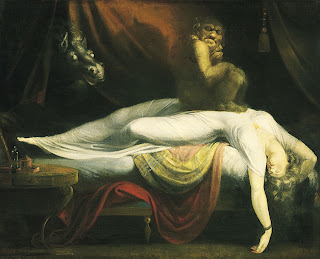Seeing pictures of ourselves in rehearsal, (funny, I don't _look_ Puckish) reminded me of the juicy gap between the play's genesis and what we're now doing with it. Surely Shakespeare would balk in puzzlement at the host of activities we now 'do' with his plays.
Like, reading them, for example. They were, after all, written to be heard, not read. The overwhelming majority of Elizabethan London was illiterate, paper and ink were prohibitively expensive, and the canon wasn't published in an organized format until seven years after his death. The very word 'audience' is echoed in journal entries of the time: "This afternoon I heard a play by a William Shakespeare ...", and stands in stark contrast with our modern habit (as spectators) of 'seeing' a movie. To the Elizabethans, language ('action of the tongue') was the firework display, the CGI, the set change, and the orchestration of entertainment. In a society commonly without books, newspapers, internets, (or blogs!), Today's Play was all of the above, plus an education on religion, the law, history, royalty, gossip, and current events.
It would be quite a feat if our Midsummer qualifies as all of the above to our Stonington _audience_ in twenty short days. But before we panic, we should remember that the original production had far less time to prepare. Contemporaries of Shakespeare's King's Men offered new plays at a furious pace, one year premiering 180 new titles. With just a few days, no Director as we know it, a grab-bag repertoire of dances and fights, and an ensemble that had been through the Wars of the Roses (on stage) together, the 'mounting' of new work must have been bracing. Also, many plays only ran one performance - and failed; as the playwright wasn't paid until the second, if there was a second, the finances must have been bracing, as well. (Well, _that_ hasn't changed!)
There are many elements I won't miss from Midsummer's Elizabethan roots (the audience's smell and their proclivity to throw vegetables, to name just two ... oh, and the plague). But as we embark on day four of rehearsal, I will revel in the luxury of in-depth character study, the collaborative generation of a vocabulary, and the flourishing of an imaginative world as fantastical as a Dream. What could be more Shakespearean than that?








